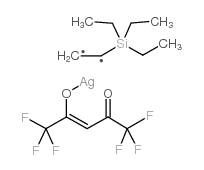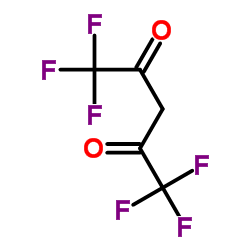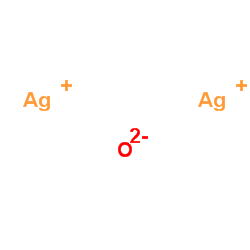177279-28-6
| 中文名 | 三乙基乙烯硅烷(六氟乙酰丙酮)银 |
|---|---|
| 英文名 | Vinyltriethylsilane(hexafluoroacetylacetonate)silver(I) |
| 分子式 | C13H19AgF6O2Si |
|---|---|
| 分子量 | 457.23300 |
| 精确质量 | 456.01100 |
| PSA | 26.30000 |
| LogP | 5.25090 |
|
Section 1: Product Identification Chemical Name:Vinyltriethylsilane(hexafluoroacetylacetonato)silver (I) (99.9%-Ag) CAS Registry Number:177279-28-6 Formula:Ag(CF3COCHCOCF3)(C8H18Si) EINECS Number:None Chemical Family:metal beta-diketonate complexes Synonym:Vinyltriethylsilylsilver(I) (hexafluoroacetylacetonato)
Section 2: Composition and Information on Ingredients IngredientCAS NumberPercentACGIH (TWA)OSHA (PEL) Title Compound177279-28-6100%0.01mg/m3 (Ag sl)0.01mg/m3 (Ag sl) Section 3: Hazards Identification Irritating to eyes, skin and respiratory tract. If inhaled or swallowed this compound may cause fluoride Emergency Overview: poisoning. Early symptoms include nausea, vomiting, diarrhea, and weakness Primary Routes of Exposure:Ingestion, inhalation, skin, eyes Eye Contact:Causes mild to severe irritation of the eyes Causes slight to mild irritation of the skin. Contact with the skin can lead to formation of dark blotches (silver Skin Contact: staining) Inhalation:Irritating to the nose, mucous membranes and respiratory tract. Ingestion may lead to dizziness, abdominal cramps, vomiting, bloody diarrhea, weakness, convulsions, and Ingestion: fluoride poisoning. Acute Health Affects:Irritating to skin, eyes and respiratory tract. Long term exposure to silver and silver salts can lead to the condition known as argyria - a general gray Chronic Health Affects:pigmentation of the skin and mucous membranes. Chronic fluoride poisoning can cause severe bone changes, loss of weight, and dental defects. NTP:No IARC:No OSHA:No SECTION 4: First Aid Measures Immediately flush the eyes with copious amounts of water for at least 10-15 minutes. A victim may need Eye Exposure: assistance in keeping their eye lids open. Get immediate medical attention. Wash the affected area with water. Remove contaminated clothes if necessary. Seek medical assistance if Skin Exposure: irritation persists. Remove the victim to fresh air. Closely monitor the victim for signs of respiratory problems, such as difficulty Inhalation: in breathing, coughing, wheezing, or pain. In such cases seek immediate medical assistance. Seek medical attention immediately. Keep the victim calm. Give the victim water (only if conscious). Induce Ingestion: vomiting only if directed by medical personnel. SECTION 5: Fire Fighting Measures Flash Point:not applicable Autoignition Temperature:none Explosion Limits:none Extinguishing Medium:none required If this product is involved in a fire, fire fighters should be equipped with a NIOSH approved positive pressure Special Fire Fighting Procedures: self- contained breathing apparatus and full protective clothing. Hazardous Combustion andIf involved in a fire material may emit toxic fumes. Decomposion Products: Unusual Fire or Explosion Hazards: No unusual fire or explosion hazards. SECTION 6: Accidental Release Measures Small spills may be mixed with diatomaceous earth, sand, vermiculite, or other suitable inert material and Spill and Leak Procedures: swept up. SECTION 7: Handling and Storage Handling and Storage:Store and handle the product under an inert atmosphere of nitrogen or argon.`Store cold. SECTION 8: Exposure Controls and Personal Protection Eye Protection:Always wear approved safety glasses when handling a chemical substance in the laboratory. Skin Protection:Wear protective clothing and gloves. Ventilation:If possible, handle the material in an efficient fume hood. If ventilation is not available a respirator should be worn. The use of respirators requires a Respirator Respirator: Protection Program to be in compliance with 29 CFR 1910.134. Ventilation:If possible, handle the material in an efficient fume hood. Additional Protection:No additional protection required. SECTION 9: Physical and Chemical Properties Color and Form:yellow liquid Molecular Weight:456.45 Melting Point:no data Boiling Point:no data Vapor Pressure:no data Specific Gravity:no data Odor:no data Solubility in Water:insoluble SECTION 10: Stability and Reactivity Stability:air sensitive (store cold) Hazardous Polymerization:no hazardous polymerization Conditions to Avoid:exposure to air or water Incompatibility:air, water, oxidizing agents, active metals Decomposition Products:carbon monoxide, carbon dioxide, organic fumes, hydrogen fluoride, and silver salts. SECTION 11: Toxicological Information RTECS Data:No information available in the RTECS files. Carcinogenic Effects:No data Mutagenic Effects:No data Tetratogenic Effects:No data SECTION 12: Ecological Information Ecological Information:No information available SECTION 13: Disposal Considerations Disposal:Dispose of according to local, state and federal regulations. SECTION 14: Transportation Shipping Name (CFR):Non-hazardous Hazard Class (CFR):NA Additional Hazard Class (CFR):NA Packaging Group (CFR):NA UN ID Number (CFR):NA Shipping Name (IATA):Non-hazardous Hazard Class (IATA):NA Additional Hazard Class (IATA):NA Packaging Group (IATA):NA UN ID Number (IATA):NA SECTION 15: Regulatory Information TSCA:Not listed in the TSCA inventory. SARA (Title 313):Title compound: See category N740 for reporting. Second Ingredient:None SECTION 16 - ADDITIONAL INFORMATION N/A |
| 风险声明 (欧洲) | 36/37/38 |
|---|---|
| 安全声明 (欧洲) | 26-36/37/39 |
|
~84% 
177279-28-6 |
| 文献:Chi, Kai-Ming; Chen, Kuo-Hsien; Peng, Shie-Ming; Lee, Gene-Hsiang Organometallics, 1996 , vol. 15, # 10 p. 2575 - 2578 |
| 上游产品 3 | |
|---|---|
| 下游产品 0 | |




